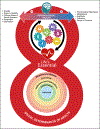Life's Essential 8: Updating and Enhancing the American Heart Association's Construct of Cardiovascular Health: A Presidential Advisory From the American Heart Association
- PMID: 35766027
- PMCID: PMC10503546
- DOI: 10.1161/CIR.0000000000001078
Life's Essential 8: Updating and Enhancing the American Heart Association's Construct of Cardiovascular Health: A Presidential Advisory From the American Heart Association
Abstract
In 2010, the American Heart Association defined a novel construct of cardiovascular health to promote a paradigm shift from a focus solely on disease treatment to one inclusive of positive health promotion and preservation across the life course in populations and individuals. Extensive subsequent evidence has provided insights into strengths and limitations of the original approach to defining and quantifying cardiovascular health. In response, the American Heart Association convened a writing group to recommend enhancements and updates. The definition and quantification of each of the original metrics (Life's Simple 7) were evaluated for responsiveness to interindividual variation and intraindividual change. New metrics were considered, and the age spectrum was expanded to include the entire life course. The foundational contexts of social determinants of health and psychological health were addressed as crucial factors in optimizing and preserving cardiovascular health. This presidential advisory introduces an enhanced approach to assessing cardiovascular health: Life's Essential 8. The components of Life's Essential 8 include diet (updated), physical activity, nicotine exposure (updated), sleep health (new), body mass index, blood lipids (updated), blood glucose (updated), and blood pressure. Each metric has a new scoring algorithm ranging from 0 to 100 points, allowing generation of a new composite cardiovascular health score (the unweighted average of all components) that also varies from 0 to 100 points. Methods for implementing cardiovascular health assessment and longitudinal monitoring are discussed, as are potential data sources and tools to promote widespread adoption in policy, public health, clinical, institutional, and community settings.
Keywords: AHA Scientific Statements; health promotion; healthy lifestyle; life change events; public health; social determinants of health.
Figures




References
-
- Lloyd-Jones DM, Hong Y, Labarthe D, Mozaffarian D, Appel LJ, Van Horn L, Greenlund K, Daniels S, Nichol G, Tomaselli GF, et al.; on behalf of the American Heart Association Strategic Planning Task Force and Statistics Committee. Defining and setting national goals for cardiovascular health promotion and disease reduction: the American Heart Association’s strategic Impact Goal through 2020 and beyond. Circulation 2010;121:586–613. doi: 10.1161/CIRCULATIONAHA.109.192703 - DOI - PubMed
-
- Gorelick PB, Furie KL, Iadecola C, Smith EE, Waddy SP, Lloyd-Jones DM, Bae HJ, Bauman MA, Dichgans M, Duncan PW, et al.; on behalf of the American Heart Association/American Stroke Association. Defining optimal brain health in adults: a presidential advisory from the American Heart Association/American Stroke Association. Stroke 2017;48:e284–e303. doi: 10.1161/STR.0000000000000148 - DOI - PMC - PubMed
-
- Virani SS, Alonso A, Benjamin EJ, Bittencourt MS, Callaway CW, Carson AP, Chamberlain AM, Chang AR, Cheng S, Delling FN, et al.; on behalf of the American Heart Association Council on Epidemiology and Prevention Statistics Committee and Stroke Statistics Subcommittee. Heart disease and stroke statistics—2020 update: a report from the American Heart Association. Circulation 2020;141:e139–e596. doi: 10.1161/CIR.0000000000000757 - DOI - PubMed
-
- Tsao CW, Aday AW, Almarzooq ZI, Alonso A, Beaton AZ, Bittencourt MS, Boehme AK, Buxton AE, Carson AP, Commodore-Mensah Y, et al.; on behalf of the American Heart Association Council on Epidemiology and Prevention Statistics Committee and Stroke Statistics Subcommittee. Heart disease and stroke statistics—2022 update: a report from the American Heart Association. Circulation 2022;145:e153–e639. doi: 10.1161/CIR.0000000000001052 - DOI - PubMed
-
- Huffman MD, Capewell S, Ning H, Shay CM, Ford ES, Lloyd-Jones DM. Cardiovascular health behavior and health factor changes (1988–2008) and projections to 2020: results from the National Health and Nutrition Examination Surveys. Circulation 2012;125:2595–2602. doi: 10.1161/CIRCULATIONAHA.111.070722 - DOI - PMC - PubMed
Publication types
MeSH terms
Grants and funding
LinkOut - more resources
Full Text Sources
Medical

